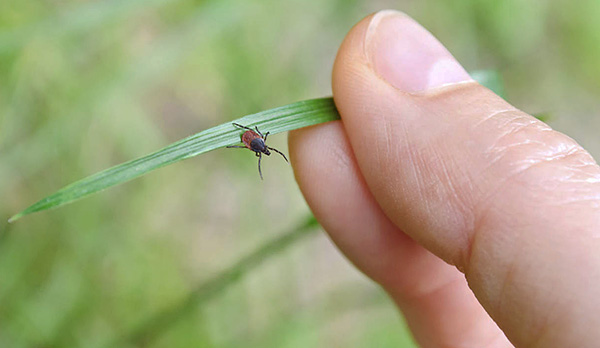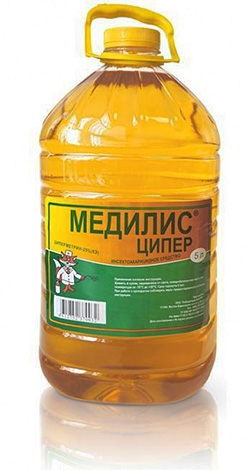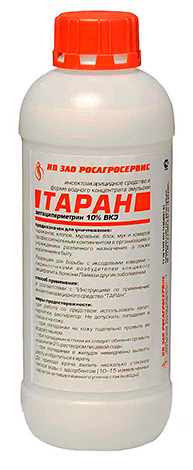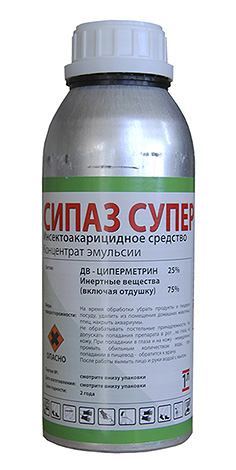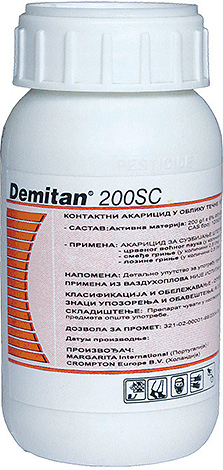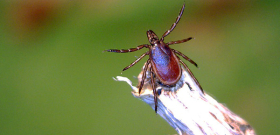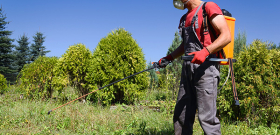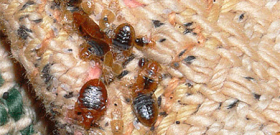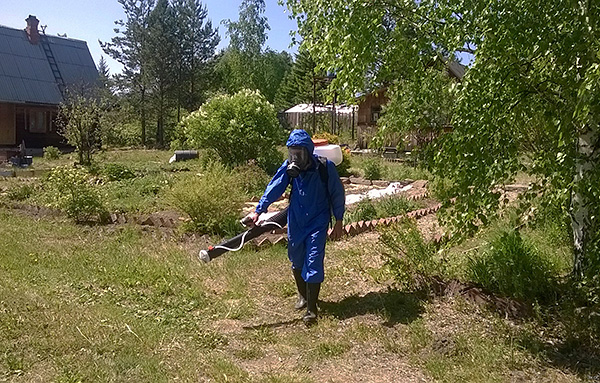
Treating an area from ticks is one of the most effective (and practical) ways to reliably secure an area from these parasites. If on excursions into the wild or on walks in city parks infested with ticks, it is wiser to wear special clothes and use repellents, then relaxing on the lawn near your own country house in anti-encephalitis overalls or being sprayed from head to toe with DEET is a very dubious decision.
At the same time, for ticks, a lawn in a suburban area, a flower garden or a vegetable garden are just as convenient hunting grounds as wild meadows, forest glades and cow pastures. So acaricidal treatment of the territory may turn out to be a good solution to the problem - ticks will be destroyed, and will not prevent the owners of the site from enjoying their rest on the lawn.

However, does such treatment always make it possible to destroy all ticks on the site? And can it be carried out in such a way that neither people nor domestic animals are harmed, and the crop sprayed with acaricidal agents can then be eaten without fear of poisoning? Let's figure it out...
How effective is the treatment of the area from ticks
The practice of pest control services shows that anti-mite treatment is very effective.Specialists who regularly carry out treatments from April-May (until the end of August) and keep in touch with their clients report that after desacarization (as the destruction of ticks in a particular area is scientifically called) within 2-3 months, approximately 70% of treated areas are neither mites nor their bites not registered at all.
On a note
Approximately 30% of land plots where early processing is carried out in April-May, in July-August, ticks are sometimes found in dogs and cats. Usually, in practice, in such cases, it is impossible to say unequivocally whether parasites have attached themselves to pets on the site itself, or whether it happened outside it, but most customers prefer not to risk it and order repeated work.
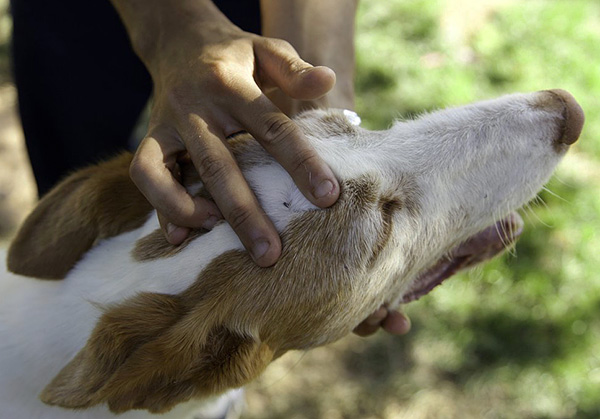
It is interesting, by the way, that those people who order anti-tick treatments every year, after the second spring treatment, almost never order the summer one. That is, if ticks are poisoned on the site for two years in a row, then for the entire season until next spring, after such a procedure, ticks are not found here.
This is a natural result in cases where the work on the destruction of ticks is carried out correctly. If the grass and soil surface are treated with an effective acaricide, then all active stages of parasites die on the territory - adults, nymphs and larvae (see also article about tick breeding). After that, there is simply no one to bite a person and his pets. And if the processing is carried out at the right time, then there are still no tick eggs left, from which the larvae could later hatch.
By themselves, ticks are immobile.They “under their own power” do not crawl more than 10-15 meters in their entire life (with the exception of only some species with a pasture type of food that can actively pursue their owners). Those types of mites, which bite humans and animals in gardens and household plots, crawl mainly along the stems of plants from the ground to the top, where they wait for animals, and again descend to the ground at night. And if they move over more or less significant distances, then only in the fur of animals to which they manage to cling.
After treatment, rodents, lizards, hedgehogs, cats and dogs can enter the site of single individuals of ticks. However, such parasites, having detached themselves from the host here, turn out to be full, and undergo metamorphosis for some time, and only then look for a host again. As a rule, if a vole or lizard brought a pumped larva or nymph to the site in June-July, then the parasite can only bite a person in August, after it has digested all the pumped blood and molts.
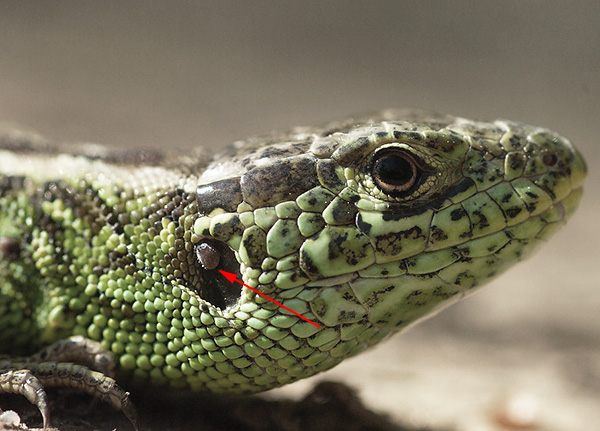
Therefore, if in early spring, when ticks awaken after winter diapause and go hunting, cultivate the site and kill all the parasites here, then they will not be here for several months, and only by the middle or end of summer can single individuals appear. These parasites, if they are lucky enough to suck blood on some animal, can lay eggs in early autumn, but bloodsuckers will pose a serious threat to humans only next year. Then, in the spring, it will be necessary to carry out the next desacarization.
On a note
Often, employees of pest control services recommend poisoning ticks on the site twice: in spring and summer.On the one hand, this guarantees the complete absence of parasites here throughout the entire tick season, plus, to a certain extent, it will help protect the site from mosquitoes (especially in August, at the very peak of "mosquito" activity). On the other hand, such recommendations are not given without mercantile considerations: acaricidal treatment of the territory is a rather expensive and profitable service for contractors, its price ranges from 1,000 rubles per hundred square meters (standard - 5,500 rubles for 6 acres) to 20,000 rubles per hectare. And if you can find any arguments to convince the client to carry out these works twice a year, then the company will find such arguments.

The effectiveness of the treatment against ticks is influenced primarily by the following factors:
- The set and number of drugs used, the type and concentration of active substances in them - it depends on how completely parasites will be destroyed in the treated area;
- The thoroughness and quality of the acaricidal treatment itself;
- Technical characteristics of the sprayers used - almost always they should be motorized sprayers, allowing you to cover a large area with a jet of product;
- The relief of the site, the abundance of decorative elements, various structures and debris on it - the more there are and the more complex the relief, the more difficult it is to evenly apply the agent to all objects and the more difficult it is to process all the tick shelters, which means that the greater the risk that individual parasites after processing survive;
- Protection of the territory from the wind and from the penetration of animals. The fewer ticks that can get here after treatment, the higher its effectiveness will be;
- The specifics of the territories adjacent to the cultivated area.The more likely there is a breeding ground for mites right behind the fence, the lower the treatment efficiency will be. The most dangerous areas in this regard are those that border directly on a forest, pasture, wasteland or park (especially if the park is abandoned). And the most prosperous are those that are surrounded on all sides by other well-groomed areas;
- The region in which the property is located. In some areas, there may be very few ticks even in the wild, but in the area there will be units that will die during processing. And in heavily tick-infested areas, even the most effective treatment sometimes gives only a short-term result - hedgehogs, shrews and mice will bring ticks in large numbers here.
This means that you need to seriously prepare for such processing - regardless of whether it will be carried out by a special service, or by the site owner himself. It is necessary to choose the right acaricidal agents and carry out all the work correctly in order to destroy ticks in the territory as completely as possible.
Do you need to treat your specific area?
First, it is useful to find out whether it is necessary to poison ticks in the area near your house or cottage in general. In many cases, people are simply frightened by the stories of relatives about tick bites, or they look at neighbors whose plot is adjacent directly to the forest and who annually carry out processing at their place.
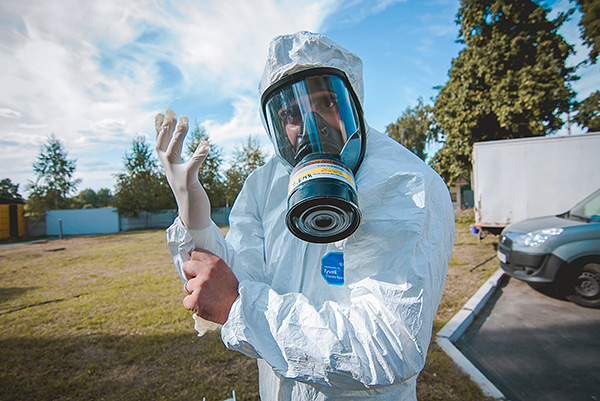
How to understand that in this particular area it is necessary to carry out acaricidal treatment? The factors contributing to this are listed below:
- If ticks are found on the site. Doesn't matter, are they encephalitic or not - if they live here, then few people can relax here on the grass with a calm heart or have picnics under the house.Ticks can be seen on tall grass stalks, they are found on clothing and on the body of people or animals that are present in the area;

- If the region as a whole is unfavorable for tick-borne encephalitis or Lyme borreliosis. This means that here, firstly, there are many ticks, and secondly, relatively many parasites are infected with the tick-borne encephalitis virus. In an ordinary garden plot, there may also be a tick infected with a pathogen - this is more than enough reason for anti-tick treatment;
- If the site directly borders on a non-residential, heavily overgrown territory - a forest, a forest belt, a wasteland, a field, a meadow, a river bank, an abandoned garden or park.
In all these situations, there is a possibility of ticks getting into the area, and sometimes infection from them with a dangerous infection. In such cases, processing of the site is needed. If ticks have never been found on the territory, it is surrounded on all sides by other inhabited areas, and tick-borne encephalitis is extremely rarely recorded in the region, then desacarization, at least, is not necessary.
On a note
An acute question for many people is why today they have stopped processing forests from ticks in the way they did in Soviet times. It is believed that then, in the era of the USSR, it was due to large-scale sweeps that ticks did not attack people in such quantities as they attack today, and tick-borne encephalitis was not so dangerous. Someone even remembers the signs in the forests with the inscription "The territory is processed from ticks."
In fact, there are a number of nuances in the issue of tick baiting in forests.Firstly, tick-borne encephalitis began to be studied thoroughly only in the post-war period, and when its danger became obvious, DDT, which was extremely harmful to many living organisms, was used to kill ticks. After the ban on DDT, it was not possible to find a sufficiently effective alternative to it - all acaricides decompose much faster. In addition, chemicals kill not only ticks, but also many beneficial insects. Be that as it may, in the end, in the days of the late USSR, no one processed forests from ticks, and vaccination of the population came to the fore as a means of preventing tick-borne encephalitis.
Some areas are subject to mandatory annual acaricidal treatment. According to the rules of SanPiN, such treatment should be carried out in regions dangerous for tick-borne encephalitis, in the territories of preschool educational institutions of all types, in common house territories and in courtyards, in city parks and public places of use.
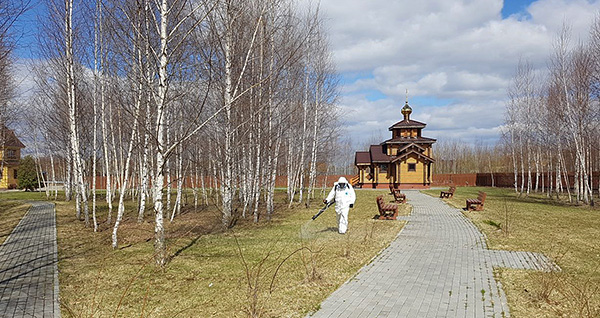
The SES is responsible for monitoring the conduct of such treatments, but it does not conduct them itself - state and communal services must independently choose a contractor to perform such work.
When and how is the treatment of the territory carried out
The main treatment against ticks should be carried out in the spring - approximately at the time when the snow completely melts and the average daily air temperature exceeds + 5 ° С. For Moscow and the Moscow region, this is approximately mid-April-early May, for Novosibirsk - early-mid-May, for Kyiv and Kharkov - late March-mid-April.
During these periods, adult ticks, larvae and nymphs emerge from wintering, all of them seek to feed and are actively looking for hosts. Adult females, after saturation, lay eggs, from which larvae emerge after a few weeks. It is this that is highly undesirable to allow on the site, so that the number of parasites here does not increase exponentially. Therefore, spring processing is recommended to be carried out during the first or second week of stable warm frost-free weather.
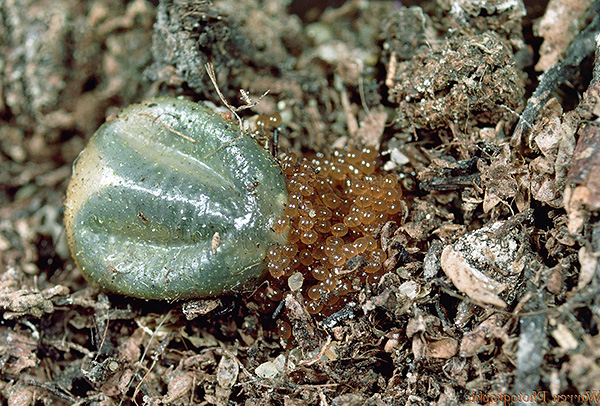
On a note
These terms are also good because various beneficial insects are still inactive at this time. If the processing is carried out now, then these assistants to the gardener and gardener will not suffer.
Summer-autumn processing is carried out in late August - early September, at the peak of activity of larvae and nymphs of ticks. If they have time to feed, then they go into the soil for the winter and actively begin to feed in early spring. By destroying them now (in September), you can significantly reduce the risk of biting in the spring, before spring processing.

At the same time, if spring treatment is considered a kind of warning, that is, its task is to prevent ticks from biting at all, then summer-autumn treatment is carried out as needed, when ticks begin to bite people and animals too intensively. If ticks do not bite people in the summer, then there is no need for such a summer-autumn treatment.
It is definitely not recommended to carry out processing during the flowering of trees and during the ripening period of crops that are eaten without washing - raspberries, currants, sea buckthorn. If the treatment is carried out during flowering, then there is a risk of poisoning pollinating insects and significantly reducing the yield.
On a note
In regions that are especially dangerous for ticks, the result of treatment lasts for 2-3 months. During this time, new ticks, which are found in abundance outside the territory, have time to penetrate the site. Here, three or even four treatments may be required from them for the entire warm season.
When processing, all grass, open ground, lawns, bushes, tree trunks, flower beds, paths and objects lying on the ground are sprayed with a composition containing a powerful acaricide (or insectoacaricide) in an effective concentration. Getting on ticks in the form of a solution, the agent kills them in just a few minutes (less often - a little more than an hour).
After drying on the grass and soil, the preparations retain their acaricidal activity and kill the mites when they crawl through the substance and soil the paws and body in the product. Such poisoning is longer - the tick can die in the time interval from 3-4 hours to 2-3 days after contact with the drug, but the ultimate goal is achieved - the parasites die.
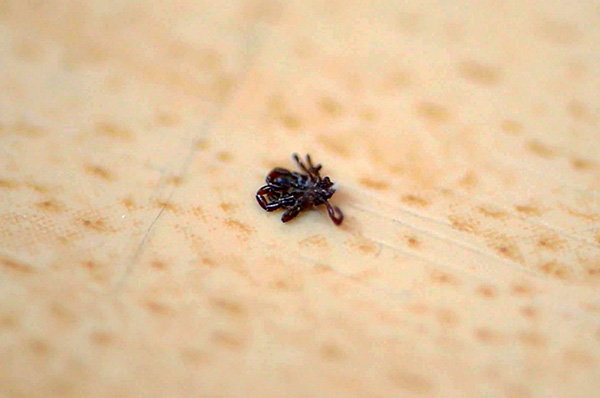
To date, there is no exact data on whether all tick eggs treated with the product are pickled. The principle of operation of the drugs used is such that, with a high probability, embryos in the treated eggs develop, but the larvae die when they hatch and come into contact with the agent located on the shell of the egg or near it. In addition, if the processing is carried out on time, then the females simply do not have time to lay eggs.
Means for the destruction of ticks in an open area
To treat areas from ticks, you can use many preparations intended for household plots and having an acaricidal effect.As a rule, these are products based on organophosphorus compounds (chlorpyrifos, karbofos, fenthion), pyrethroids (cypermethrin, deltamethrin) and some others. Ticks rarely develop resistance to these active ingredients, and preparations based on them remain effective for a long time.
Among these tools, the most popular and have the most positive reviews are the following:
- Medilis Cyper is a product based on cypermethrin. It is produced in various packages - 50 ml, 500 ml (for treating premises from synanthropic insects) and 5 l (for use against ixodid ticks in open areas). A container for 5 liters of liquid costs about 9,000 rubles;

- Taran is a remedy with zeta-cypermethrin, similar in activity to cypermethrin. A 1 liter canister costs about 2000 rubles;

- Sipaz Super is an analogue of Medilis-Ziper, also based on cypermethrin. The price of a container for 1 liter is about 2500 rubles;

- Propargit-based Omite is a specialized acaricide, the effective consumption of which is approximately 2 liters per hectare of cultivated area. The price of a container for 1 liter is about 1500 rubles;

- Demitan - a dry concentrate based on phenazakhine, costs about 5500 rubles per 1 kg;

- Dobrokhim FOS is an acute agent based on fenthion. The price of 1 liter is about 2500 rubles. This amount is enough to obtain 50 liters of working solution, which will be enough to process 500 square meters. m. territory.

Important!
Do not confuse preparations for the destruction of ticks in animals with means for treating the territory from blood-sucking ticks. For example, it is often believed that if the drug Neostomazan helps to poison ticks on dogs, horses and cows, then the area can also be treated with it.This is not so: the product is highly effective only on the skin of animals, and on grass and earth its action is not enough even for the emergency destruction of ticks. Moreover, the cost of the drug for processing a more or less vast area will be very high.
All of the above funds are quite affordable for retail purchase and self-use. Specialists in pest control services often use them, as well as some more professional tools, the names of which they, however, do not disclose and store them as their own developments. However, practice shows that the above drugs are very effective with proper independent use.
On a note
It is strongly not recommended to use products based on the same active substance all the time. This can lead to the development of resistance in ticks to this substance and the ineffectiveness of the remedy. Each subsequent treatment must be carried out with a product based on a different active ingredient, preferably a different class (for example, alternate pyrethroids with organophosphorus).
But folk remedies will not reliably and completely destroy ticks on the site. Practice shows that various recipes based on tar water, vinegar or laundry soap are significantly inferior to modern "chemistry".
Preparation of the territory for decontamination works
For the most effective processing, the territory for it needs to be prepared.First of all, all objects, garbage, rubbish, last year's leaves should be removed from the ground and grass - everything that is not needed on the lawn itself, in the garden or in the flower garden, but in which ticks can hide and which will require additional consumption of the drug.
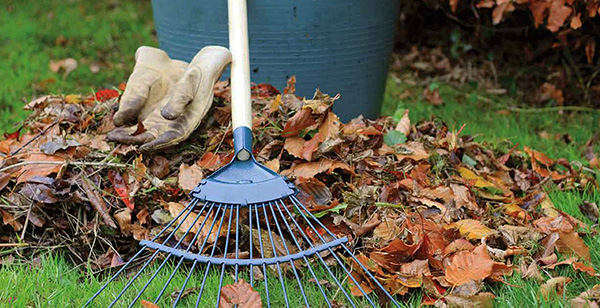
If fallen leaves have not been removed since last year, they should be collected and removed from the site, or burned - it is in them and under them that ticks most often hibernate. Those parasites that were between the leaves will simply be removed from the site, and those that were hiding under the foliage will die from the drug falling on them.
It is highly desirable to mow all the grass on the lawn and, moreover, dry or perennial weeds in the garden and garden. They are a kind of reservoir not only for wintering ixodid ticks, but also for spider mites, which will then pose a threat to garden crops.
In addition, the higher the grass, the more funds will have to be spent to spray the territory, and this will lead to an increase in the cost of treatment, and it does not matter whether the owner of the territory buys the drug himself, or decides to order desacarization on an ad. On a new, not yet landscaped site, you need to mow all the weeds and, if possible, dig up the ground.
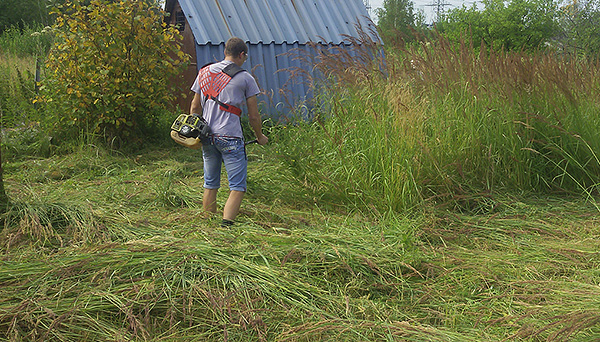
The next thing is that if a dog lives on the site, then it is imperative to take the doghouse to the open area and disassemble it. It is here that whole generations of ticks can winter and live all year round - they suck blood on the dog, then hide in the crack of the booth, molt, get out and bite the animal again. It is necessary to make sure that when processing the drug, it is possible to spray both the booth and the place under it and near it as carefully as possible.
It is also necessary to free the approaches to the fences on both sides - from the side of the site and from the side of the street. Here you should mow the grass, so that then you can spray both the fence itself and the ground under it as carefully as possible. This will greatly help to protect the site from the penetration of ticks in the future.
All this must be done regardless of whether it is decided to carry out acaricidal treatment on your own, or this service is ordered from a company. When contacting the service, the operator will list these works and ask to carry them out before the arrival of the exterminator.
Finally, before processing, you need to check the weather forecast - neither on the day of processing, nor within 3-4 days after it, there should be rain or frost. The rain will wash the agent off the grass, and then the ticks will not come into contact with it, and in case of frost they will not get out of the soil at all and will not crawl along the blades of grass covered with a chemical acaricide.
The procedure for anti-tick treatment
Before processing, it is necessary to prepare a means, an apparatus for spraying the working solution and special clothing that will cover the surface of the handler's body as completely as possible.
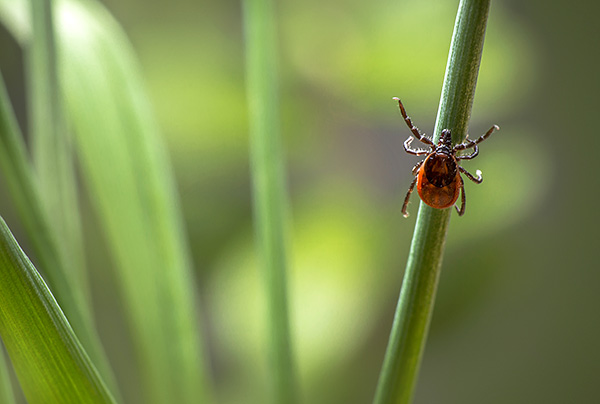
Then:
- The drug is diluted in water at the concentration indicated in the instructions for use. According to the same instructions, it is necessary to calculate the consumption rates of the working solution and prepare as much of it as is required to treat a particular area. If it is not enough, then in the future it will be possible to prepare another part - it will be safer and more environmentally friendly than pouring out an unused drug;
- The finished solution is poured into the sprayer - depending on its design, it is either pressurized, or it is connected to the network or started, the processor puts it on his back and starts spraying. If a sprayer is rented or bought for work, then a motorized sprayer should be preferred to a manual sprayer, since it will take about two to three times longer to process the area manually;
- The handler takes precautionary measures: brings dogs and cats into the house, takes children and people who are not involved in the work from the site, puts on a respirator, hat or hood, gloves;
- From the sprayer, the working solution is applied to all grass, earth, stones and other objects that lie on the ground. Arbors, decorative elements, flower beds, alpine slides, curbs of paths, edges of the blind area of buildings, bases of bushes and trees are also processed. The dog house is sprayed separately and especially carefully;
- The protective zone on the outside of the fence for 10-20 meters is also carefully processed.
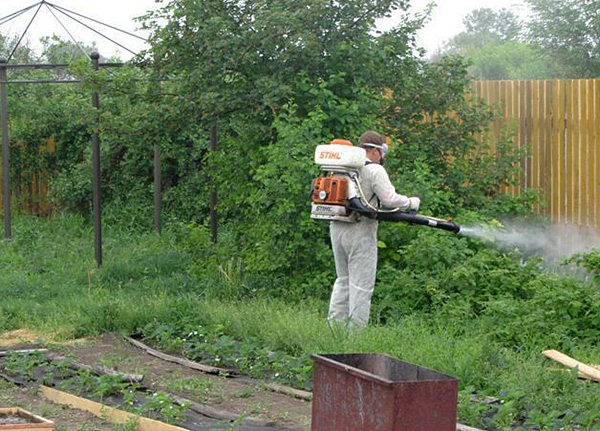
After treatment, pets and children should not be released to the site until the end of the day. The product will dry here, and after drying it will no longer pose a danger to anyone except arthropods. Even if dew appears on the grass the next day, it will not wash off the preparation.
The dog house can be assembled and put back in place the next day after treatment, when it is completely dry.
Is the effect quickly achieved and how long does it last?
As practice shows, after professional spraying, ticks cannot be found on the site already on the day of treatment. In the conditions of the Moscow region, ticks are absent on the site after such treatment for at least 2 months.
The bulk of the ticks die in the first hours after the treatment of the territory, the rest die within the next 2-3 days.
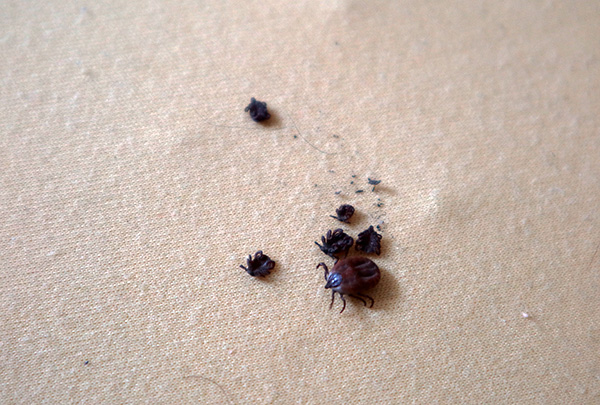
Laboratory tests of products show that mites die when treated directly with the drug within the first 60 minutes on average (depending on the active substance in the product). And in contact with the treated grass - within 12 hours.
From the morning of the next day, you can already walk, relax and spend time on the site in the same way as it was done before processing.
Means on the grass and the ground dries in 2-3 hours at an air temperature of 7-10°C and clear weather. After drying, the drug no longer poses a danger to people and pets.
The duration of the protective action of the product depends on how soon after the treatment it rains. With rainwater, the drug is partially washed off the grass and absorbed into the soil.
With independent desacarization, the results and the rate of death of ticks will depend on the chosen agent, its concentration and the quality of spraying the area. Ticks can disappear just as quickly and for as long a time as with professional treatment. But they can also be detected here immediately after processing, and a short time after it, if the work was carried out with certain violations.
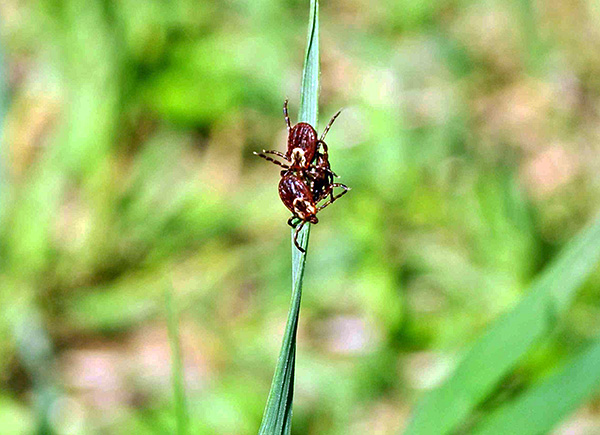
After treatment, new mites may appear on the site in single quantities and will survive here if at least one rain has passed before. Such invasions will be single, so that the parasites that have come here again will begin to bite people and domestic animals, in the worst case, only after one and a half to two months.
Which is better: self-treatment of the site, or calling a special service
Theoretically, it does not matter who performs the treatment - the exterminator, or the owner of the site himself.If carried out correctly and by effective means, the result will be the same.
In practice, professional processing in most cases is more effective than independent processing. Moreover, sometimes do-it-yourself desacarization does not work at all and does not help get rid of ticks on the site.

The reason for these differences is that professional exterminators use equipment and preparations that are generally not available to private site owners. First of all, these are units for spraying the solution - each such device is very expensive and completely irrational for home use, but it is he who gives out the widest and longest jet of aerosol, which allows you to process a hundred square meters in 5-6 minutes with the most dense coverage of soil or grass means. The same area with a conventional garden sprayer with the same density will either not be able to be processed at all, or it will take at least half an hour.
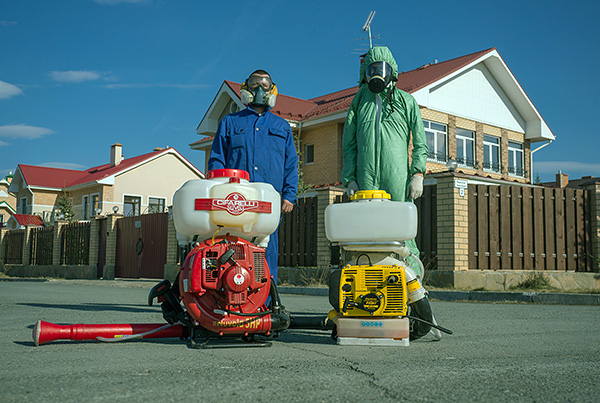
In addition, professional insecticides are usually more toxic to mites and provide a faster and longer lasting effect. Plus, you need to remember that competent exterminators who really love their job try different combinations of drugs and can choose a complex that in a particular area at a particular time of the year will be more effective than any single remedy.
And of course, one cannot discount the professional experience and knowledge of a specialist. With hundreds of treatments per season, they face a variety of situations and know how to get the mites out anyway. A person who cultivates the local area for the first or second time in his life simply does not have such an understanding.
This is not true for all firms.Today, there are many private master hacks on the market, as well as many one-day firms that register a new site and name every season so as not to deal with negative reviews from last year. So the choice of the performer, if it comes to this, must be treated carefully.
If you have personal experience in treating the territory from ticks (independently or with the help of a company), be sure to share the information by leaving your review at the bottom of the page.
This is how the treatment of the area from ticks should be

